I use two parameters to check if a reed is set up the way I like it.
The first is the distance I can bend the reed before it chokes, the second is the amount of air that escapes along the reed while it is choked.
I try to get the isolated reed to bend at least a quartertone, maybe a little more, before it chokes.
When it chokes there should be as little air leakage as possible. The reed will never fully close the slot, but there is a big difference between a howling wind and a soft breeze.
I like my reeds very straight and the gaps very low, so arcing usually means getting rid of the arc the manufacturer has put on the reed.
I have found that I get the best result when the reed is dipped slightly at the point where it leaves the plate, near the rivet, and comes up straight after that.
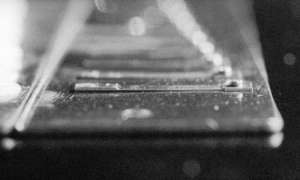 Sideview of a new reedplate (click to enlarge).
Sideview of a new reedplate (click to enlarge).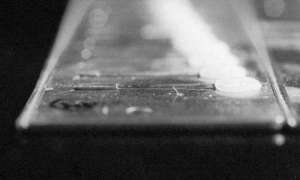 Sideview of a plate after arcing.
Sideview of a plate after arcing.Narrowing the slots will very likely have bent your reeds out of shape. The reed will probably be bent down into the slot, curved around the edge of the plate.
When bending it back up, make sure the reed doesn't bend back at the rivet but just a little past the edge of the plate so that the curve around the edge, causing the reed to dip into the plate, remains in the reed.
The curve at the edge of the plate is very small and hardly visible, but the effect on the leakage of the whole reed can be dramatic.
After this point I try to get the reed to be as straight as possible, always aiming to get as little leakage as possible from the reed when it is choked.
%3Cobject%20width%3D%22640%22%20height%3D%22385%22%3E%3Cparam%20name%3D%22movie%22%20value%3D%22https%3A//www.youtube.com/v/Sqf2g5ZtSKI%26hl%3Den_US%26fs%3D1%26rel%3D0%26color1%3D0x3a3a3a%26color2%3D0x999999%22%3E%3C/param%3E%3Cparam%20name%3D%22allowFullScreen%22%20value%3D%22true%22%3E%3C/param%3E%3Cparam%20name%3D%22allowscriptaccess%22%20value%3D%22always%22%3E%3C/param%3E%3Cembed%20src%3D%22https%3A//www.youtube.com/v/Sqf2g5ZtSKI%26hl%3Den_US%26fs%3D1%26rel%3D0%26color1%3D0x3a3a3a%26color2%3D0x999999%22%20type%3D%22application/x-shockwave-flash%22%20allowscriptaccess%3D%22always%22%20allowfullscreen%3D%22true%22%20width%3D%22640%22%20height%3D%22385%22%3E%3C/embed%3E%3C/object%3E
All this is a matter of trial and error, so I suggest you get a pair of old plates to practice on before you tackle your favorite harmonica.
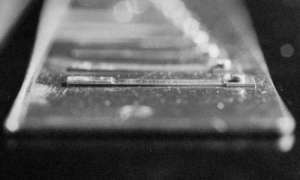 New plate.
New plate.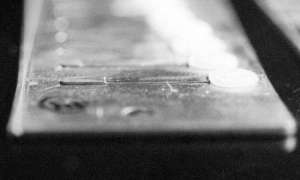 Plate after embossing and arcing .
Plate after embossing and arcing .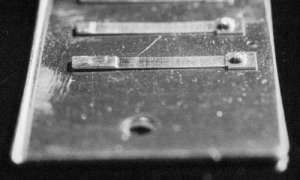 New Plate.
New Plate.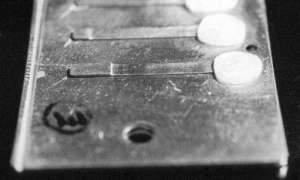 Plate after embossing and arcing.
Plate after embossing and arcing.
The arc of the reeds is very important too, try to get the reeds as straight as possible.
I tried arcing my reeds and it worked well on some, but I'm having leakage and response time problems on my 9 and 10 draws and blows and my 7 blow is leaky and bends too easily. What would you recommend I do to fix it?
- Austin
Quick question: Is arcing the main or only technique to set the point where the blow reed chokes? I keep fiddling with arcing one reed (Blow #4) and it seems to consistently bend at least a whole step before choking. . . Embossing further won't change that, will it?
I try to not to ask anything that hasn't been covered elsewhere here, but I looked all around and I think I'm the first for this question. :-)
Thanks again!
but believe me if u try to drawbend holes 2 & 3 by lawering your lawer jaw
your throat will open much wider and your back tongue will go down making a bigger chamber and you'll be able to bend stone reeds.
but as long as you told me not to do it, i will abide by your rules master :)
regards
Don' move your jaw when you bend, try to do all your bending from the back of the tongue/top of the throat.
Maybe work on your technique more then on the harp :)
but tinus i didn't get the part of the transition.
how can i feel it to modify?
so if the blow reed is participating quicly,
will it be faster and esier for the draw reed to respond for bending down on hole 2 and 3 ?
anyway on holes 2, 3 i open much wider my lawer jaw when draw bending down after the 1/2 step down, don't know if i should set the reed for my technic or not cz it sucks the bending air powerfuly tightly.
regards, thanks
The reeds work together, the tighter the blowreed is gapped the longer it will participate in the bent note. You can adjust where the transition between the blow and draw reed happens by opening or closing the drawreed. I suggest you try a few. I try to make sure that the transition never happens on a note. So not on the halfstep bends but somewhere between the half and hole step bends in hole 2 and 3.
ruppet oysler recommands curving not arcing(the middle of the reed goes towards the slot).and it is obvious that curving closes the slot for tightning the air.
i am realy lost, what result gives each one?
what should be done to the draw reed to have an easy drawbend response after gapping close the blow reed specially on hole 2 and 3
thanks forward
Also in setting up your harp to do these will undoubtely play sticky in some notes.In my other comment I explained one of my problems.
http://overblow.com/?menuid=140
but you painted on the draw reeds.
why are you doing?
Is it just practice Item, the wax?
Are you using the wax harmonica when you perfomance?
I can't believe your clear overband sound!!
http://jbutler.co.kr/sites/patient%20care.htm
please more simple answer. korean diatonic harmornica technical is very low. but my teacher and I learned overbands, but we need more smooth sound like you. thank you
http://overblow.com/?menuid=140
is it paraffin?or bonding?
what's that something on the reeds?
If you mean the blow and draw reeds then yes.. you adjust both the reeds. If you are saying does it arc up and down then yes. The arc is very slightly down at the rivet then up at 1/3 of the reedlength from the rivet and then straight out for the rest of the reed length.
I am just getting into harp modification and wondered which plate sto gap, arc, and set up first. The blow or the draw reeds? The blow reeds are supposed to have a larger gap right? Is it a case of try the blow then the draw until you get both responding properly.
Many thanks
Great site!
If someday you come to play here in Brazil, please let me know.
However the main reason for a reed to be functioning badly after gapping or arcing would be that it has been gapped too tight. The reed needs a tiny offset from the plate in order for it to be accelerated enough to allow it to pass through the plate. If the gap is too tight it becomes very difficult to play the reed.
Problems of the first kind kan be detected by simply holding the reedplate against the light and checking for contact between the reed and the reedplate or for foreign objects.
If it is the gap that is the problem just slightly widen the gap and your problem should be over.
The 7th draw reed is not sounding loud as the others...It seems it is a little stucked. Can you help me? Thanks!
I am new to harp modifications.
I was trying to arc my A harmonica but the 7th draw reed stopped bending down...How can I fix it?
Your site is very good.Thanks!
Es tut mir leid aber mein deutsch ist wirklich nich gut genug um die info im Deutsch zu ubersetzen. Ich hoffe das du mit der hilfe fon babelfish oder ein anderen translator die info doch verstehen kanst. Wann das nicht hilfst kanst du mir naturlich ein email schicken und dan versuche ich im meinem steinkohlen deutsch ein und anderes zu erklaren.
mit großer Neugier und Interesse habe ich versucht deine interessanten Informationen
über das modifizieren der Harps gelesen.Ich habe leider nicht alles richtig verstanden wegen dem englisch.(Fachbegriffe) Wäre überaus dankbr dafür,wenn es eine Möglichkeit gäbe,die Ifos in deutsch zu erhalten.Vielleicht hast du eine Idee das zu machen.Ich finde deine Site großartiig.
Herzliche Grüße Peer.
If the tip of the reed is turned up I hold down the tip and the rivetend with a finger and push with the screwdriver from under the plate in the middle of the reed.
If the tip is turned down too much I just pus with the screwdriver at the tip (from under the plate) while holding the reed down at the rivet.
All this is rather subtle work ant takes some Fingerspitzengefühl.